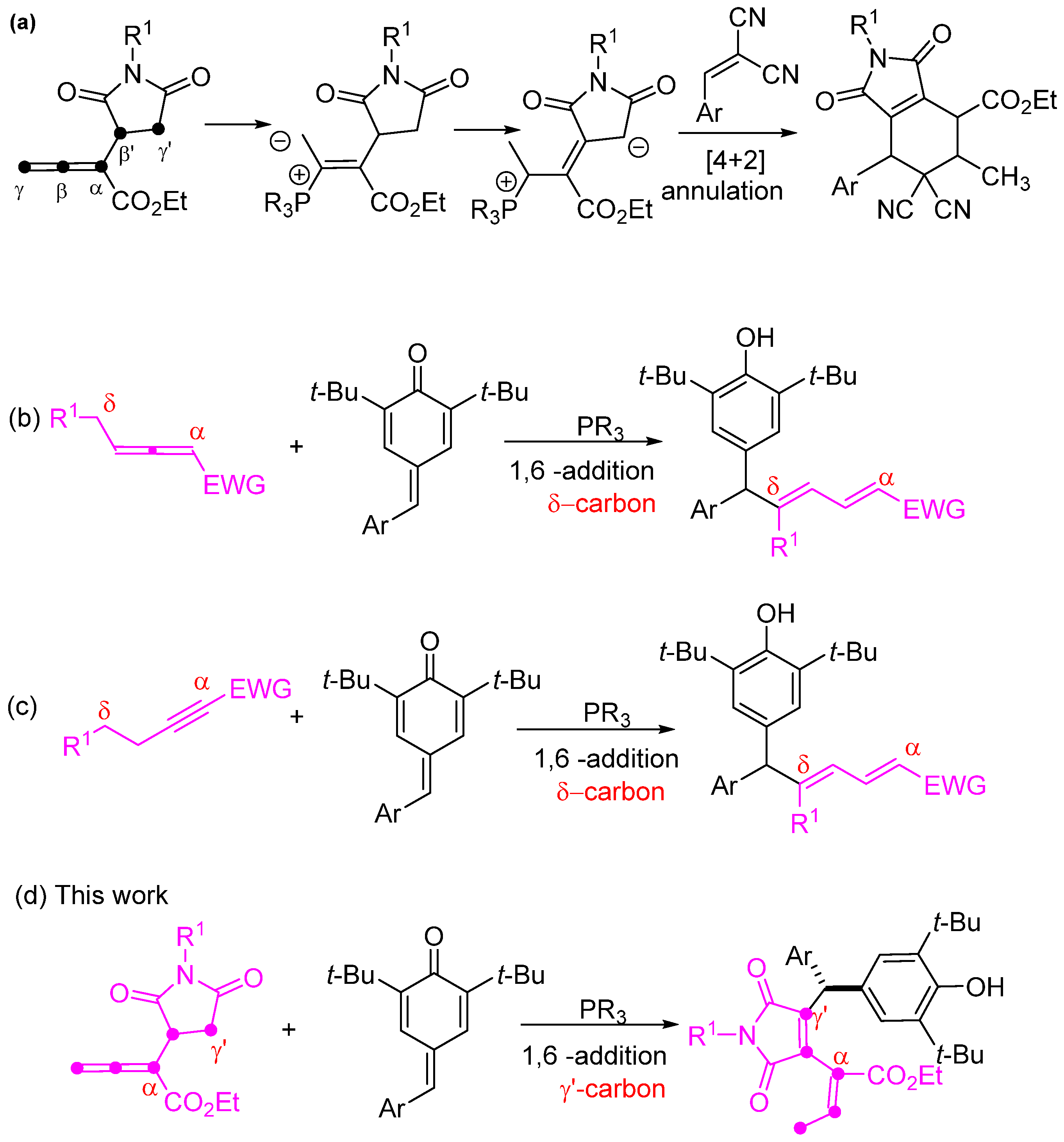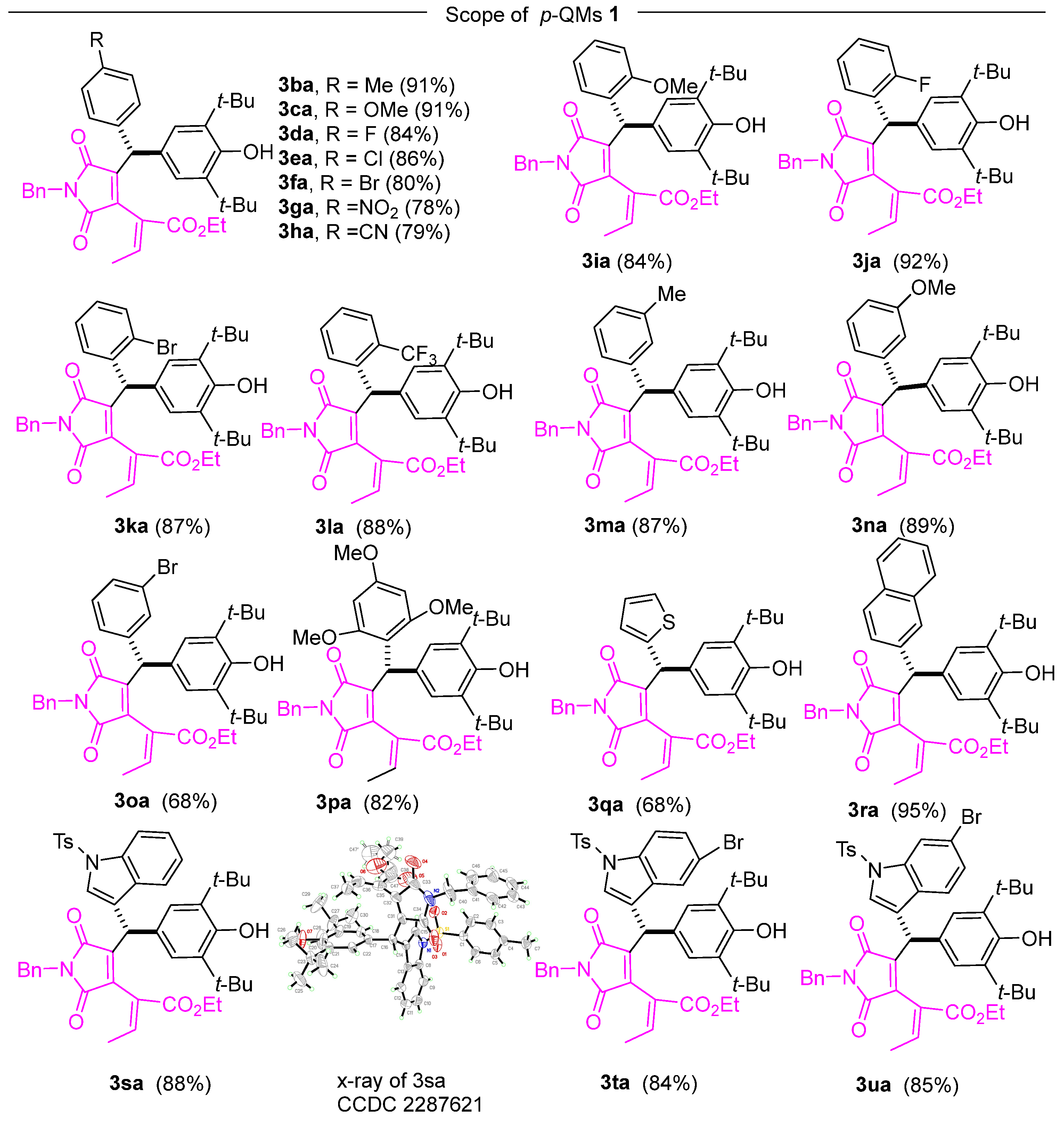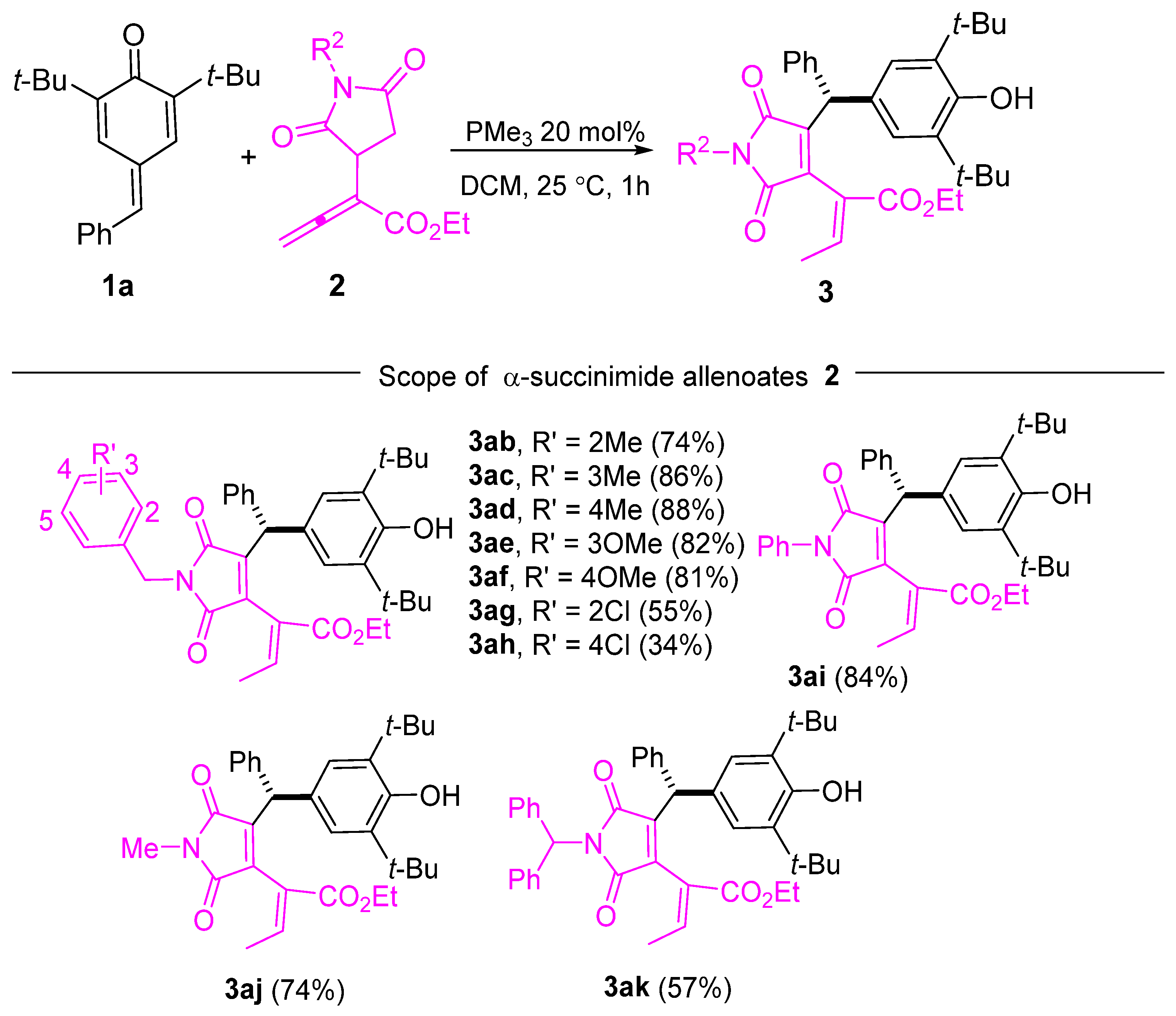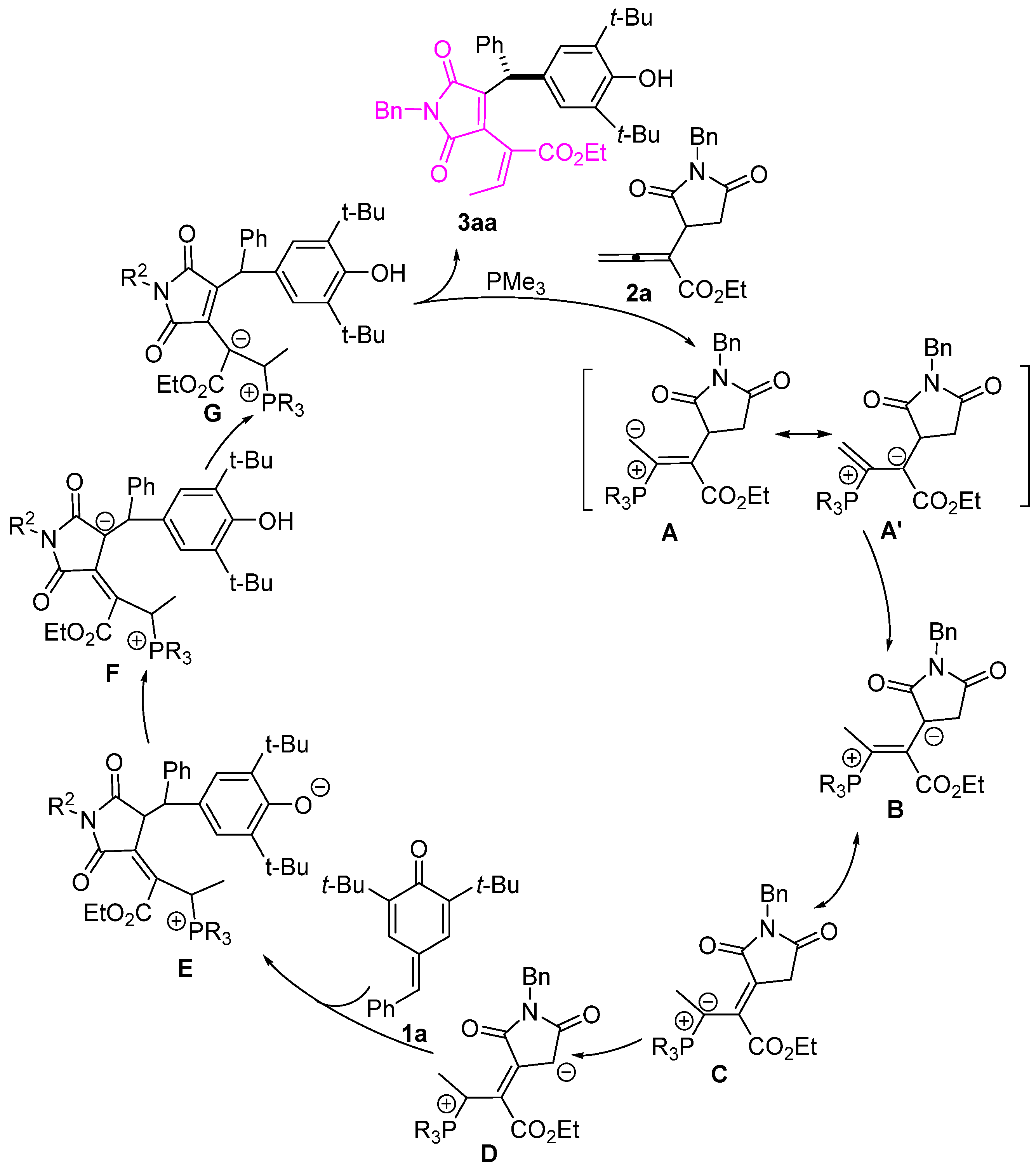Phosphine-Catalyzed γ′-Carbon 1,6-Conjugate Addition of α-Succinimide Substituted Allenoates with Para-Quinone Methides: Synthesis of 4-Diarylmethylated 3,4-Disubstituted Maleimides
Abstract
:1. Introduction
2. Results and Discussion
3. Materials and Methods
3.1. General Procedure for the Synthesis of Para-Quinone Methides 1
3.2. General Procedure for the Synthesis of α-Succinimide Substituted Allenoates 2
3.3. General Procedure for the Phosphine-Catalyzed Direct 1,6-Conjugate Addition
4. Conclusions
Supplementary Materials
Author Contributions
Funding
Institutional Review Board Statement
Informed Consent Statement
Data Availability Statement
Conflicts of Interest
References
- Wang, Z.; Xu, X.; Kwon, O. Phosphine Catalysis of Allenes with Electrophiles. Chem. Soc. Rev. 2014, 43, 2927–2940. [Google Scholar] [CrossRef] [PubMed]
- Xiao, Y.; Sun, Z.; Guo, H.; Kwon, O. Chiral Phosphines in Nucleophilic Organocatalysis. Beilstein J. Org. Chem. 2014, 10, 2089–2121. [Google Scholar] [CrossRef] [PubMed]
- Li, W.; Zhang, J. Recent Developments in the Synthesis and Utilization of Chiral β-Aminophosphine Derivatives as Catalysts or Ligands. Chem. Soc. Rev. 2016, 45, 1657–1677. [Google Scholar] [CrossRef] [PubMed]
- Xiao, Y.; Guo, H.; Kwon, O. Nucleophilic Chiral Phosphines: Powerful and Versatile Catalysts for Asymmetric Annulations. Aldrichim. Acta 2016, 49, 3–41. [Google Scholar]
- Wang, T.; Han, X.; Zhong, F.; Yao, W.; Lu, Y. Amino Acid Derived Bifunctional Phosphines for Enantioselective Transformations. Acc. Chem. Res. 2016, 49, 1369–1378. [Google Scholar] [CrossRef] [PubMed]
- Zhou, L.; Guo, H. Acidic Hydrogen-Tethered Electron-Deficient Acceptors for Phosphine-Catalyzed Annulations. Synlett 2024, 35. [Google Scholar] [CrossRef]
- Wei, Y.; Shi, M. Lu’s [3 + 2] Cycloaddition of Allenes with Electrophiles: Discovery, Development and Synthetic Application. Org. Chem. Front. 2017, 4, 1876–1890. [Google Scholar] [CrossRef]
- Ni, H.; Chan, W.L.; Lu, Y. Phosphine-Catalyzed Asymmetric Organic Reactions. Chem. Rev. 2018, 118, 9344–9411. [Google Scholar] [CrossRef] [PubMed]
- Guo, H.; Fan, Y.C.; Sun, Z.; Wu, Y.; Kwon, O. Phosphine Organocatalysis. Chem. Rev. 2018, 118, 10049–10293. [Google Scholar] [CrossRef]
- Li, E.Q.; Huang, Y. Recent Advances in Phosphine catalysis Involving γ-Substituted Allenoates. Chem. Commun. 2020, 56, 680–694. [Google Scholar] [CrossRef] [PubMed]
- Huang, Y.; Liao, J.; Wang, W.; Liu, H.; Guo, H. Synthesis of Heterocyclic Compounds through Nucleophilic Phosphinecatalysis. Chem. Commun. 2020, 56, 15235–15281. [Google Scholar] [CrossRef] [PubMed]
- Xie, C.; Smaligo, A.J.; Song, X.-R.; Kwon, O. Phosphorus-Based Catalysis. ACS Cent. Sci. 2021, 7, 536–558. [Google Scholar] [CrossRef] [PubMed]
- Zhu, X.F.; Lan, J.; Kwon, O. An Expedient Phosphine-Catalyzed [4 + 2] Annulation: Synthesis of Highly Functionalized Tetrahydropyridines. J. Am. Chem. Soc. 2003, 125, 4716–4717. [Google Scholar] [CrossRef] [PubMed]
- Wurz, R.P.; Fu, G.C. Catalytic Asymmetric Synthesis of Piperidine Derivatives through the [4 + 2] Annulation of Imines with Allenes. J. Am. Chem. Soc. 2005, 127, 12234–12235. [Google Scholar] [CrossRef] [PubMed]
- Tran, Y.S.; Kwon, O. Phosphine-Catalyzed [4 + 2] Annulation: Synthesis of Cyclohexenes. J. Am. Chem. Soc. 2007, 129, 12632–12633. [Google Scholar] [CrossRef] [PubMed]
- Guo, H.; Xu, Q.; Kwon, O. PhosphinePromoted [3 + 3] Annulations of Aziridines with Allenoates: Facile Entry into Highly Functionalized Tetrahydropyridines. J. Am. Chem. Soc. 2009, 131, 6318–6319. [Google Scholar] [CrossRef] [PubMed]
- Zhang, Q.; Yang, L.; Tong, X. 2-(Acetoxymethyl)buta-2,3-dienoate, a Versatile 1,4-Biselectrophile for Phosphine-Catalyzed [4+n] Annulations with 1,n-Bisnucleophiles (n =1, 2). J. Am. Chem. Soc. 2010, 132, 2550–2551. [Google Scholar] [CrossRef] [PubMed]
- Na, R.; Jing, C.; Xu, Q.; Jiang, H.; Wu, X.; Shi, J.; Zhong, J.; Wang, M.; Benitez, D.; Tkatchouk, E.; et al. Phosphine Catalyzed Annulations of Azomethine Imines: Allene-Dependent [3 + 2], [3 + 3], [4 + 3], and [3 + 2 + 3] Pathways. J. Am. Chem. Soc. 2011, 133, 13337–13348. [Google Scholar] [CrossRef] [PubMed]
- Szeto, J.; Sriramurthy, V.; Kwon, O. Phosphine-Initiated General Base Catalysis: Facile Access to Benzannulated 1,3-Diheteroatom Five-Membered Rings via Double-Michael Reactions of Allenes. Org. Lett. 2011, 13, 5420–5423. [Google Scholar] [CrossRef]
- Yang, W.; Zhang, Y.; Qiu, S.; Zhao, C.; Zhang, L.; Liu, H.; Zhou, L.; Xiao, Y.; Guo, H. Phosphine-Catalyzed [4 + 2] Cycloaddition of Unsaturated Pyrazolones with Allenoates: A Concise Approach toward Spiropyrazolones. RSC Adv. 2015, 5, 62343–62347. [Google Scholar] [CrossRef]
- Liu, H.; Liu, Y.; Yuan, C.; Wang, G.-P.; Zhu, S.-F.; Wu, Y.; Wang, B.; Sun, Z.; Xiao, Y.; Zhou, Q.-L.; et al. Enantioselective Synthesis of Spirobarbiturate Cyclohexenes through Phosphine-Catalyzed Asymmetric [4 + 2] Annulation of Barbiturate-Derived Alkenes with Allenoates. Org. Lett. 2016, 18, 1302–1305. [Google Scholar] [CrossRef]
- Yuan, C.; Zhou, L.; Xia, M.; Sun, Z.; Wang, D.; Guo, H. Phosphine-Catalyzed Enantioselective [4 + 3] Annulation of Allenoates with C, N-Cyclic Azomethine Imines: Synthesis of Quinazoline-Based Tricyclic Heterocycles. Org. Lett. 2016, 18, 5644–5647. [Google Scholar] [CrossRef]
- Ni, H.; Yao, W.; Waheed, A.; Ullah, N.; Lu, Y. Enantioselective [4 + 2]-Annulation of Oxadienes and Allenones catalyzed by an Amino Acid Derived Phosphine: Synthesis of Functionalized Dihydropyrans. Org. Lett. 2016, 18, 2138–2141. [Google Scholar] [CrossRef]
- Wang, C.; Gao, Z.; Zhou, L.; Yuan, C.; Sun, Z.; Xiao, Y.; Guo, H. Phosphine-Catalyzed [2 + 4] Annulation of Allenoates with Thiazolone-Derived Alkenes: Synthesis of Functionalized 6,7- Dihydro-5H-pyrano [2,3-d]thiazoles. Org. Lett. 2016, 18, 3418–3421. [Google Scholar] [CrossRef] [PubMed]
- Wang, Z.; Xu, H.; Su, Q.; Hu, P.; Shao, P.L.; He, Y.; Lu, Y. Enantioselective Synthesis of Tetrahydropyridines/piperidines via Stepwise [4 + 2]/[2 + 2] Cyclizations. Org. Lett. 2017, 19, 3111–3114. [Google Scholar] [CrossRef]
- Wang, C.; Jia, H.; Zhang, C.; Gao, Z.; Zhou, L.; Yuan, C.; Xiao, Y.; Guo, H. Phosphine-Catalyzed Enantioselective [2 + 4] Cycloaddition to Synthesize Pyrrolidin-2-one Fused Dihydropyrans Using α-Substituted Allenoates as C2 Synthons. J. Org. Chem. 2017, 82, 633–641. [Google Scholar] [CrossRef] [PubMed]
- Wang, H.; Lu, W.; Zhang, J. Ferrocene Derived Bifunctional Phosphine-Catalyzed Asymmetric Oxa-[4 + 2] Cycloaddition of αSubstituted Allenones with Enones. Chem.-Eur. J. 2017, 23, 13587–13590. [Google Scholar] [CrossRef]
- Ni, H.; Tang, X.; Zheng, W.; Yao, W.; Ullah, N.; Lu, Y. Enantioselective Phosphine-Catalyzed Formal [4 + 4] Annulation of α,β-Unsaturated Imines and Allene Ketones: Construction of Eight-membered Rings. Angew. Chem. Int. Ed. 2017, 56, 14222–14226. [Google Scholar] [CrossRef]
- Zielke, K.; Waser, M. Formal [4 + 1]-Addition of Allenoates to o-QuinoneMethides. Org. Lett. 2018, 20, 768–771. [Google Scholar] [CrossRef]
- Yao, C.; Bao, Y.; Lu, T.; Zhou, Q. Stereoselective Synthesis of Functionalized Benzooxazepino[5,4-a]isoindolone Derivatives via Cesium Carbonate Catalyzed Formal [5 + 2] Annulation of 2-(2-Hydroxy-phenyl)-isoindoline-1,3-dione with Allenoates. Org. Lett. 2018, 20, 2152–2155. [Google Scholar] [CrossRef] [PubMed]
- Gao, Z.; Wang, C.; Zhou, L.; Yuan, C.; Xiao, Y.; Guo, H. Phosphine-Catalyzed [8 + 2]-Annulation of Heptafulvenes with Allenoates and Its Asymmetric Variant: Construction of Bicyclo[5.3.0]decane Scaffold. Org. Lett. 2018, 20, 4302–4305. [Google Scholar] [CrossRef] [PubMed]
- Zhu, Y.; Wang, D.; Huang, Y. Phosphine Sequentially Catalyzed Domino 1,6-Addition/Annulation: Access to Functionalized Chromans and Tetrahydroquinolines with an Ethynyl-Substituted All Carbon Quaternary Center. Org. Lett. 2019, 21, 908–912. [Google Scholar] [CrossRef] [PubMed]
- Zhang, Q.; Jin, H.; Feng, J.; Zhu, Y.; Jia, P.; Wu, C.; Huang, Y. Sequential Phosphine-Catalyzed [4 + 2] Annulation of β′-Acetoxy Allenoates: Enantioselective Synthesis of 3-Ethynyl-Substituted Tetrahydroquinolines. Org. Lett. 2019, 21, 1407–1411. [Google Scholar] [CrossRef] [PubMed]
- Gao, Z.; Zhou, X.; Xie, L.; Wang, X.; Wang, S.; Liu, H.; Guo, H. Phosphine-Catalyzed [4 + 2] Annulation of Allenoates Bearing Acidic Hydrogen with 1,1-Dicyanoalkenes. J. Org. Chem. 2024, 89, 7169–7174. [Google Scholar] [CrossRef] [PubMed]
- Mao, B.; Shi, W.; Liao, J.; Liu, H.; Zhang, C.; Guo, H. Phosphine-Catalyzed [4 + 2] Annulation of Allenoate with SulfamateDerived Cyclic Imines: A Reaction Mode Involving γ′-Carbon of α-Substituted Allenoate. Org. Lett. 2017, 19, 6340–6343. [Google Scholar] [CrossRef] [PubMed]
- Shi, W.; Ren, Y.; Zhao, H.; Tang, Y.; Piao, S.; Mao, B.; Wang, W.; Wu, Y.; Wang, B.; Guo, H. Phosphine-Catalyzed (4 + 2) Annulation of Allenoates with Benzofuran-Derived Azadienes and Subsequent Thio-Michael Addition. Org. Lett. 2022, 24, 3747–3752. [Google Scholar] [CrossRef] [PubMed]
- Li, W.; Xu, X.; Zhang, P.; Li, P. Recent Advances in the Catalytic Enantioselective Reactions of para-Quinone Methides. Chem. Asian J. 2018, 13, 2350–2359. [Google Scholar] [CrossRef] [PubMed]
- Wang, J.; Hao, W.; Tu, S.; Jiang, B. Recent Developments in 1,6-Addition Reactions of para-Quinone Methides (p-QMs). Org. Chem. Front. 2020, 13, 1743–1778. [Google Scholar] [CrossRef]
- Lima, C.; Pauli, F.; Costa, D.; Souza, A.; Forezi, L.; Ferreira, V.; Silva, F. para-Quinone Methides as Acceptors in 1,6-Nucleophilic Conjugate Addition Reactions for the Synthesis of Structurally Diverse Molecules. Eur. J. Org. Chem. 2020, 18, 2650–2692. [Google Scholar] [CrossRef]
- More, S.; Rupanawar, B.; Suryavanshi, G. Metal-Free, Acid-Catalyzed 1, 6-Conjugate Addition of NH-Sulfoximines to para-Quinone Methides: Accessing to Diarylmethine Imino Sulfanone. J. Org. Chem. 2021, 86, 10129–10139. [Google Scholar] [CrossRef] [PubMed]
- Yu, K.; Ge, X.; Fan, Y.; Liu, X.; Yang, X.; Yang, Y.; Zhao, X.; An, X.; Fan, C. Iron(iii)-Catalyzed Tandem Annulation of Indolyl-Substituted p-Quinone Methides with Ynamides for the Synthesis of Cyclopenta[b]indoles. Chem. Commun. 2022, 58, 8710–8713. [Google Scholar] [CrossRef] [PubMed]
- Wang, J.; Hao, W.; Tu, S.; Jiang, B. Catalytic Asymmetric 1,6-Conjugate Addition of para-Quinone Methides: Formation of All-Carbon Quaternary Stereocenters. Angew. Chem. Int. Ed. 2015, 54, 13711–13714. [Google Scholar] [CrossRef] [PubMed]
- Liu, X.; Liu, B.; Shi, Z.; Tan, C.; Fan, R.; Li, Z.; Tan, J. Hf(OTf)4-Catalyzed 1, 6-Conjugate Addition of 2-Alkyl-azaarenes to para -Quinone Methides. J. Org. Chem. 2021, 86, 3615–3624. [Google Scholar] [CrossRef] [PubMed]
- Wang, Y.; Wang, K.; Cao, W.; Liu, X.; Feng, X. Diastereo- and Enantioselective 1, 6-Conjugate Addition of 2-Azaarylacetamides to para-Quinone Methides. Org. Lett. 2019, 21, 6063–6067. [Google Scholar] [CrossRef] [PubMed]
- Zheng, K.; Liu, X.; Feng, X. Recent Advances in Metal-Catalyzed Asymmetric 1, 4-Conjugate Addition (ACA) of Nonorganometallic Nucleophiles. Chem. Rev. 2018, 118, 7586–7656. [Google Scholar] [CrossRef] [PubMed]
- Ma, C.; Huang, Y.; Zhao, Y. Stereoselective 1,6-Conjugate Addition/Annulation of para-Quinone Methides with Vinyl Epoxides/Cyclopropanes. ACS Catal. 2016, 6, 6408–6412. [Google Scholar] [CrossRef]
- Sharma, B.; Shinde, D.; Jain, R.; Begari, E.; Satbhaiya, S.; Gonnade, R.; Kumar, P. Unravelling the Nucleophilicity of Butenolides for 1,6-Conjugate Addition to p-Quinone Methides: A Direct Access to Diversely Substituted Butenolide-Derived Diarylmethanes. Org. Lett. 2018, 20, 2787–2791. [Google Scholar] [CrossRef] [PubMed]
- Ranga, P.; Ahmad, F.; Nager, P.; Rana, P.; Anand, R. Bis(amino)cyclopropenium Ion as a Hydrogen-Bond Donor Catalyst for 1,6-Conjugate Addition Reactions. J. Org. Chem. 2021, 86, 4994–5010. [Google Scholar] [CrossRef] [PubMed]
- Wang, D.; Song, Z.; Wang, W.; Xu, T. Highly Regio- and Enantioselective Dienylation of p-Quinone Methides Enabled by an Organocatalyzed Isomerization/Addition Cascade of Allenoates. Org. Lett. 2019, 21, 3963–3967. [Google Scholar] [CrossRef] [PubMed]
- Song, Z.; Wang, W.; Liu, Z.; Lu, Y.; Wang, D. Phosphine-Catalyzed Intermolecular Dienylation of Alkynoate with para-Quinone Methides. J. Org. Chem. 2021, 86, 8590–8599. [Google Scholar] [CrossRef]
- Wood, P.; Woo, L.; Labrosse, J.; Trusselle, M.; Abbate, S.; Longhi, G.; Castiglioni, E.; Lebon, F.; Purohit, A.; Reed, M.; et al. Chiral Aromatase and Dual Aromatase-Steroid Sulfatase Inhibitors from the Letrozole Template: Synthesis, Absolute Configuration, and In Vitro Activity. J. Med. Chem. 2008, 51, 4226–4238. [Google Scholar] [CrossRef] [PubMed]
- Shiri, M.; Zolfigol, M.; Kruger, H.; Tanbakouchian, Z. Bis- and Trisindolylmethanes (BIMs and TIMs). Chem. Rev. 2010, 110, 2250–2293. [Google Scholar] [CrossRef] [PubMed]
- He, Q.; Sun, F.; Zheng, X.; You, S. Brønsted Acid Catalyzed Synthesis of Unsymmetrical Arylbis(3-indolyl)-methanes. Synlett 2009, 7, 1111–1114. [Google Scholar]
- Mondal, S.; Panda, G. Synthetic Methodologies of Achiral Diarylmethanols, Diaryl and Triarylmethanes (TRAMs) and Medicinal Properties of Diaryl and Triarylmethanes-an overview. RSC Adv. 2014, 4, 28317–28358. [Google Scholar] [CrossRef]
- Cho, S.; Yoon, K.; Chintharlapalli, S.; Abdelrahim, M.; Lei, P. Nur77 Agonists Induce Proapoptotic Genes and Responses in Colon Cancer Cells through Nuclear Receptor–Dependent and Nuclear Receptor–Independent Pathways. Cancer Res. 2007, 67, 674–683. [Google Scholar] [CrossRef] [PubMed]
- Antus, S.; Schindlbeck, E.; Ahmad, S.; Seligmann, O.; Chari, V.; Wagner, H. Synthesis of Melanervin from Melaleuca Quinquenervia, the First Naturally Occurring Compound with a Triphenylmethane Structure. Tetrahedron 1982, 38, 133–137. [Google Scholar] [CrossRef]
- Duxbury, D.F. The Photochemistry and Photophysics of Triphenylmethane Dyes in Solid and Liquid Media. Chem. Rev. 1993, 93, 381–433. [Google Scholar] [CrossRef]
- Li, X.; Xu, X.; Wei, W.; Lin, A.; Yao, H. Organocatalyzed Asymmetric 1, 6-Conjugate Addition of para-Quinone Methides with Dicyanoolefins. Org. Lett. 2016, 18, 428–431. [Google Scholar] [CrossRef] [PubMed]
- Arde, P.; Anand, R. Expedient Access to Unsymmetrical Triarylmethanes through N-Heterocyclic Carbene Catalysed 1,6-Conjugate Addition of 2-Naphthols to para-Quinone Methides. RSC Adv. 2016, 6, 77111–77115. [Google Scholar] [CrossRef]
- Crystallographic data for 3sa has been deposited with the Cambridge Crystallograohic Data Centre as deposition number CCDC 2287621. 2023. [CrossRef]
- Goswami, P.; Anand, R.V. Bi (OTf) 3 Catalyzed Solvent Free Approach to Unsymmetrical Diaryl (2-indolyl) methanes through 1, 6-Conjugate Addition of 3-Substituted Indoles to para-Quinone Methides. ChemistrySelect 2016, 1, 2556–2559. [Google Scholar] [CrossRef]
- Zhao, Q.Y.; Pei, C.K.; Guan, X.Y.; Shi, M. Enantioselective Intermolecular Rauhut–Currier Reaction of Electron-Deficient Allenes with Maleimides. Adv. Synth. Catal. 2011, 353, 1973–1979. [Google Scholar] [CrossRef]






 | ||||
|---|---|---|---|---|
| Entry a | PR3 | Solvent | Time/h | Yield/% b |
| 1 | MePPh2 | DCM | 1 | 34 |
| 2 | EtPPh2 | DCM | 1 | Trace |
| 3 | PrPPh2 | DCM | 1 | Trace |
| 4 | Me2PPh | DCM | 1 | 67 |
| 5 | PMe3 | DCM | 1 | 92 |
| 6 | PBu3 | DCM | 1 | 40 |
| 7 | PCy3 | DCM | 1 | 20 |
| 8 | PMe3 | DCE | 2 | 90 |
| 9 | PMe3 | Toluene | 1 | 84 |
| 10 | PMe3 | THF | 1 | 73 |
| 11 | PMe3 | EtOAc | 1 | 61 |
| 12 | PMe3 | MeOH | 1 | 19 |
| 13 | PMe3 | CH3CN | 1 | NR |
| 14 c | PMe3 | DCM | 5 | 85 |
| 15 d | PMe3 | DCM | 10 | 75 |
Disclaimer/Publisher’s Note: The statements, opinions and data contained in all publications are solely those of the individual author(s) and contributor(s) and not of MDPI and/or the editor(s). MDPI and/or the editor(s) disclaim responsibility for any injury to people or property resulting from any ideas, methods, instructions or products referred to in the content. |
© 2024 by the authors. Licensee MDPI, Basel, Switzerland. This article is an open access article distributed under the terms and conditions of the Creative Commons Attribution (CC BY) license (https://creativecommons.org/licenses/by/4.0/).
Share and Cite
Gao, Z.; Zhou, X.; Liu, D.; Nie, B.; Lu, H.; Chen, X.; Wu, J.; Li, L.; Wang, X. Phosphine-Catalyzed γ′-Carbon 1,6-Conjugate Addition of α-Succinimide Substituted Allenoates with Para-Quinone Methides: Synthesis of 4-Diarylmethylated 3,4-Disubstituted Maleimides. Molecules 2024, 29, 2593. https://doi.org/10.3390/molecules29112593
Gao Z, Zhou X, Liu D, Nie B, Lu H, Chen X, Wu J, Li L, Wang X. Phosphine-Catalyzed γ′-Carbon 1,6-Conjugate Addition of α-Succinimide Substituted Allenoates with Para-Quinone Methides: Synthesis of 4-Diarylmethylated 3,4-Disubstituted Maleimides. Molecules. 2024; 29(11):2593. https://doi.org/10.3390/molecules29112593
Chicago/Turabian StyleGao, Zhenzhen, Xiaoming Zhou, Dandan Liu, Baoshen Nie, Hanchong Lu, Xiaotong Chen, Jiahui Wu, Lei Li, and Xuekun Wang. 2024. "Phosphine-Catalyzed γ′-Carbon 1,6-Conjugate Addition of α-Succinimide Substituted Allenoates with Para-Quinone Methides: Synthesis of 4-Diarylmethylated 3,4-Disubstituted Maleimides" Molecules 29, no. 11: 2593. https://doi.org/10.3390/molecules29112593
APA StyleGao, Z., Zhou, X., Liu, D., Nie, B., Lu, H., Chen, X., Wu, J., Li, L., & Wang, X. (2024). Phosphine-Catalyzed γ′-Carbon 1,6-Conjugate Addition of α-Succinimide Substituted Allenoates with Para-Quinone Methides: Synthesis of 4-Diarylmethylated 3,4-Disubstituted Maleimides. Molecules, 29(11), 2593. https://doi.org/10.3390/molecules29112593







